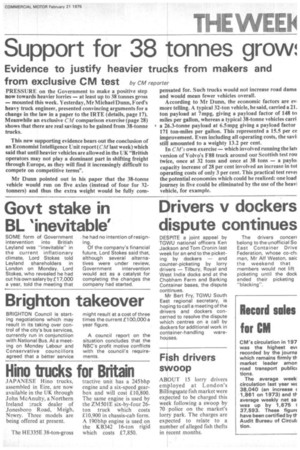Support for 38 tonnes grow
Page 15

If you've noticed an error in this article please click here to report it so we can fix it.
Evidence to justify heavier trucks from makers and from exclusive CM test by CM reporter PRESSURE on the Government to make a positive step T1OW towards heavier lorries — at least up to 38 tonnes gross — mounted this week. Yesterday, Mr Michael Dunn, Ford's heavy truck engineer, presented convincing arguments for a change in the law in a paper to the IRTE (details, page 17). Meanwhile an exclusive CM comparison exercise (page 28) shows that there are real savings to be gained from 38-tonne trucks.
This new supporting evidence bears out the conclusion of an Economist Intelligence Unit report (CM last week) which said that until heavier vehicles are allowed in the UK "British operators may not play a dominant part in shifting freight through Europe, as they will find it increasingly difficult to compete on competitive terms".
Mr Dunn pointed out in his paper that the 38-tonne vehicle would run on five axles (instead of four for 12tonners) and thus the extra weight would be fully corn pensated for. Such trucks would not increase road dama and would mean fewer vehicles overall.
According to Mr Dunn, the economic factors are ev. more telling. A typical 32-ton vehicle, he said, carried a 21. ton payload at 7mpg, giving a payload factor of 148 to miles per gallon, whereas a typical 38-tonne vehicles learnt I a 26.3-tonne payload at 6.5 mpg giving a payload factor 171 ton-miles per gallon. This represented a 15.5 per ce improvement. Even including all operating costs, the savi: still amounted to a weighty 13.2 per cent.
In CM's own exercise — which involved running the lat( version of Volvo's F88 truck around our Scottish test rou twice, once at 32 tons and once at 38 tons — a paylo: capacity increase of 28 per cent involved an increase in tot operating costs of only 3 per cent. This practical test revet the potential economies which could be realized: one load journey in five could be eliminated by the use of the heavi vehicle, for example.












































































































